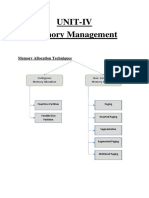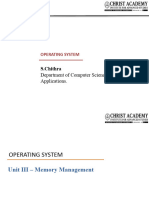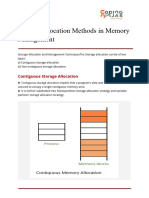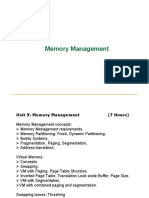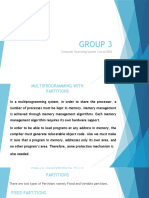0% found this document useful (0 votes)
35 views8 pagesContiguous Memory Allocation
The document discusses memory management strategies, focusing on Contiguous Memory Allocation, which allocates a single continuous block of memory for each process. It outlines two types of contiguous allocation: Static Partitioning, which is simple but can waste space, and Dynamic Partitioning, which is flexible but can lead to external fragmentation. Additionally, it compares Contiguous Allocation with Non-Contiguous Allocation, highlighting their respective advantages and disadvantages.
Uploaded by
Ytber UprCopyright
© © All Rights Reserved
We take content rights seriously. If you suspect this is your content, claim it here.
Available Formats
Download as PDF, TXT or read online on Scribd
0% found this document useful (0 votes)
35 views8 pagesContiguous Memory Allocation
The document discusses memory management strategies, focusing on Contiguous Memory Allocation, which allocates a single continuous block of memory for each process. It outlines two types of contiguous allocation: Static Partitioning, which is simple but can waste space, and Dynamic Partitioning, which is flexible but can lead to external fragmentation. Additionally, it compares Contiguous Allocation with Non-Contiguous Allocation, highlighting their respective advantages and disadvantages.
Uploaded by
Ytber UprCopyright
© © All Rights Reserved
We take content rights seriously. If you suspect this is your content, claim it here.
Available Formats
Download as PDF, TXT or read online on Scribd
/ 8



